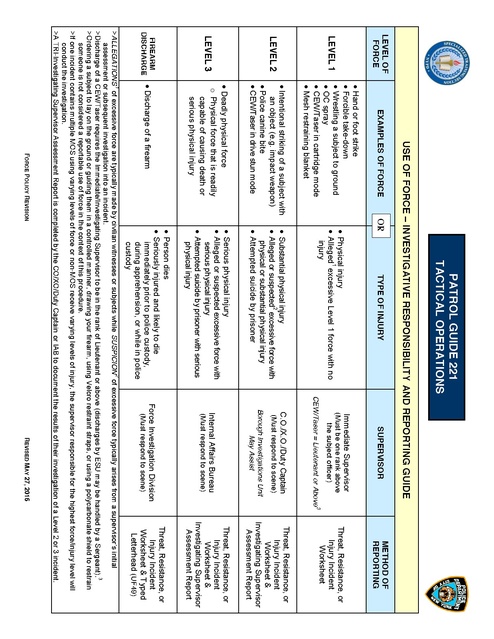Use of Force Supervisor Reporting Guide, NYPD, 2016
Download original document:

Document text

Document text
This text is machine-read, and may contain errors. Check the original document to verify accuracy.
LEVEL OF FORCE LEVEL 1 LEVEL 2 LEVEL 3 FIREARM DISCHARGE -Kidnapping for International Law Enforcement Investigators C PATROL GUIDE 221 TACTICAL OPERATIONS Physical injury 1 Alleged excessive Level 1 force with no injury (Must respond to scene) Force Investigation Division (Must respond to scene) Internal Affairs Bureau Borough Investigations Unit May Assist (Must respond to scene) C.O./X.O./Duty Captain CEW/Taser = Lieutenant or Above (Must be one rank above the subject officer) Immediate Supervisor SUPERVISOR USE OF FORCE – INVESTIGATIVE RESPONSIBILITY AND REPORTING GUIDE Hand or foot strike Forcible take-down Wrestling a subject to ground OC spray CEW/Taser in cartridge mode Mesh restraining blanket Substantial physical injury 2 Alleged or suspected excessive force with physical or substantial physical injury Attempted suicide by prisoner TYPE OF INJURY Intentional striking of a subject with an object (e.g. impact weapon) Police canine bite CEW/Taser in drive stun mode Serious physical injury Alleged or suspected excessive force with serious physical injury Attempted suicide by prisoner with serious physical injury OR Deadly physical force o Physical force that is readily capable of causing death or serious physical injury EXAMPLES OF FORCE Discharge of a firearm 2 Person dies Seriously injured and likely to die immediately prior to police custody, during apprehension, or while in police custody 1 REVISED M AY 27, 2016 3 METHOD OF REPORTING Threat, Resistance, or Injury Incident Worksheet Threat, Resistance, or Injury Incident Worksheet & Investigating Supervisor Assessment Report Threat, Resistance, or Injury Incident Worksheet & Investigating Supervisor Assessment Report Threat, Resistance, or Injury Incident Worksheet & Typed Letterhead (UF49) >ALLEGATIONS of excessive force are typically made by civilian witnesses or subjects while SUSPICION of excessive force typically arises from a supervisor’s initial assessment or subsequent investigation into an incident. 3 >Discharge of a CEW/Taser requires the Immediate/Investigating Supervisor to be in the rank of Lieutenant or above (discharges by ESU may be handled by a Sergeant). >Ordering a subject to lay on the ground or guiding them in a controlled manner, drawing your firearm, using Velcro restraint straps, or using a polycarbonate shield to restrain someone is not considered a reportable use of force in the context of this procedure. >If one incident contains multiple MOS using varying levels of force or non-MOS receive varying levels of injury, the supervisor responsible for the highest force/injury level will conduct the investigation. >A TRI-Investigating Supervisor Assessment Report is completed by the CO/XO/Duty Captain or IAB to document the results of their investigation of a Level 2 or 3 incident. FORCE POLICY REVISION -Kidnapping for International Law Enforcement Investigators C PATROL GUIDE 221 TACTICAL OPERATIONS TYPES OF INJURY OR ILLNESS DEFINED Impairment of physical condition and/or substantial pain, including: PHYSICAL INJURY a. Minor swelling, contusion(s), laceration(s), and/or abrasion(s) b. Complaint of substantial pain Any substantial impairment of physical condition or substantial protracted pain, including: SUBSTANTIAL PHYSICAL INJURY OR ILLNESS a. Significant contusion(s) b. Laceration(s) requiring multiple sutures c. Any injury or condition that resulted from police contact or action requiring treatment at a hospital emergency room Physical injury or illness which creates a substantial risk of death, or which causes death or serious and protracted disfigurement, protracted impairment of health, or protracted loss or impairment of the function of any bodily organ or limb, including: a. Broken/fractured bone(s) SERIOUS PHYSICAL INJURY OR ILLNESS b. Any injury or condition that resulted from police contact or action resulting in a hospital admission c. Gunshot wound d. Heart attack, stroke, or other life-threatening/serious illness/injury NOTES: Minor redness or a complaint of pain or discomfort resulting from the proper use of handcuffs does not constitute a Physical Injury, nor does a complaint of substantial pain related to drug withdrawal or a previously existing medical condition. These complaints, while not defined as a Physical Injury for reporting and investigation purposes, will nevertheless be treated by promptly obtaining proper medical attention when requested or visibly necessary. Any illness or injury sustained by a subject prior to police action that requires transport to and treatment at a hospital emergency room shall not be deemed a Substantial Physical Injury in the context of this procedure (i.e. narcotics dependency/withdrawal or a pre-existing medical condition). A TRI Report will not be prepared in these instances. See PG 210-04, Prisoners Requiring Medical/Psychiatric Treatment. The routine washing of a subject's eyes subsequent to the discharge of OC spray or the removal of CEW/Taser darts and routine examination of a subject who received a CEW/Taser discharge at a hospital emergency room shall not be classified as a Substantial Physical Injury in the context of this procedure. RESISTING ARREST RECIDIVIST: A suspect who is currently under arrest for Assault 2° (PL 120.05[3]), Assault on a Police Officer/Fireman/EMS Professional (PL 120.08), or Resisting Arrest (PL 205.30) and has two (2) or more prior arrests for one of these offenses within the last five (5) years. The Detective Squad Supervisor will ensure that all such Recidivist type arrests are enhanced by the local Detective Squad and that the District Attorney’s Office puts forth all efforts towards a successful prosecution. NEW FORCE PROHIBITIONS: Force will not be used to prevent a subject from swallowing contraband or to remove it from his/her mouth or body cavity. A CEW/Taser will not be discharged in cartridge or drive stun mode on a rear handcuffed subject. FORCE POLICY REVISION REVISED M AY 27, 2016





